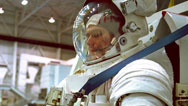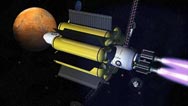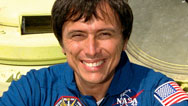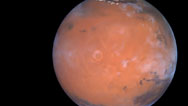Profile: Franklin Chang-Diaz
- Posted 07.14.09
- NOVA scienceNOW
(This video is no longer available for streaming.) Franklin Chang-Díaz was NASA's first Latin-American to go into space, and he's been there seven times, which ties the record. But his greatest accomplishment may be yet to come. The Costa Rican native is designing a plasma-based rocket engine that he believes will revolutionize space travel, putting our entire solar system at our disposal.
Transcript
Profile: Franklin Chang Díaz
PBS Airdate: July 14, 2009
NEIL DeGRASSE TYSON: A lot of us are hoping that someday soon, people are going to board a spaceship and travel to Mars, which, on a good day, is at least 40 million miles away.
Right now, that trip takes about seven months, each way. But since there's no filling stations or places to go shopping en route, that means you've got to pack your ride with at least 14 months of supplies.
But what if you built a spaceship that could go much faster, and make the round trip in about three months? Well, in this episode's profile, we meet a rocket scientist who thinks he knows how to do it. And his new rocket could shave months off a commute to the Red Planet.
Franklin Chang Díaz loves watching Star Trek with his wife and youngest daughter.
FRANKLIN CHANG DíAZ: I've been a Trekkie since I came to the United States. We watch the episodes over and over and over again.
MIRANDA CHANG DíAZ (Franklin Chang Díaz's Daughter): My dad kind of passed this rule that we can't watch it without him.
NEIL DeGRASSE TYSON: Franklin's favorite character? Mr. Spock.
FRANKLIN CHANG DíAZ: He has a very important position of leadership in his crew. Mr. Spock is a scientist, but he also flies.
NEIL DeGRASSE TYSON: Like Spock, Franklin knows a few things about being a scientist and a space traveler. He was NASA's first Latin American astronaut to go into space.
NASA MISSION CONTROL (Archival Footage): We have liftoff, liftoff of Columbia, mission 61-C.
NEIL DeGRASSE TYSON: He's been to space seven times, which ties the record. And he spent the last three decades developing a futuristic rocket engine.
FRANKLIN CHANG DíAZ: I believe that this rocket will revolutionize space travel. We will have the entire solar system at our disposal.
NEIL DeGRASSE TYSON: Franklin's journey began in the Central American country of Costa Rica, where he dreamt of becoming an astronaut.
FRANKLIN CHANG DíAZ: I was probably about four or five, and I took my sister, at 2:00 or 3:00 in the morning, and we climbed to the roof of our house. And we sat on the roof, eating grapefruits with sugar and looking at the stars. The sky was absolutely beautiful. I knew that among those stars there were other worlds, other places, and I wanted to be there. I wanted to go there.
NEIL DeGRASSE TYSON: His first step toward space travel? He built a rocket for his high school science fair.
FRANKLIN CHANG DíAZ: It had a little capsule, with a small mouse and a parachute. And of course, the first stage was a complete failure and the mouse survived, which was a real triumph.
NEIL DeGRASSE TYSON: When he finished high school, Franklin was determined to become an astronaut. His father took out a loan and bought him a ticket to the United States.
FRANKLIN CHANG DíAZ: And he said, "Look, this is all I can do for you right now." My parents never said, "It cannot be done."
NEIL DeGRASSE TYSON: With only $50 in his pocket and no knowledge of English, Franklin arrived at the home of cousins in Hartford, Connecticut. He enrolled in high school, worked hard to learn English and let everyone know he meant business.
FRANKLIN CHANG DíAZ: I decided that I would wear a tie and a jacket every single day. And so, my teachers were, actually, a little bit surprised to see this boy coming to school with a tie and jacket, with some weird dreams about going into space.
NEIL DeGRASSE TYSON: His hard work paid off, and he won a full scholarship to college.
Within four years, Franklin had started a family and was a graduate student at M.I.T., studying nuclear fusion and developing concepts for an experimental rocket engine.
FRANKLIN CHANG DíAZ: The idea began as a result of my Ph.D. thesis. It was clear to me that chemical rockets, the conventional rockets that we had been using all along, were not really going to give us the capability to travel far, to Mars, to Jupiter.
NEIL DeGRASSE TYSON: He was on the road to building his first real rocket, when, in 1977, NASA issued a call for a new group of astronauts. Thirty-five-hundred would apply, only 15 would be chosen. Franklin was one of those 15.
MARIA (Franklin Chang Díaz's Mother): When he called us, I was so overcome with emotion that I yelled, "He did it! He did it!" And my husband was crying. He cried with tears, but he couldn't speak. I was the only woman in the country who was a mother of an astronaut, no one else.
NASA MISSION CONTROL (Archival Footage): T minus 20 seconds.
FRANKLIN CHANG DíAZ: What I had prepared for, for my entire life...
NASA MISSION CONTROL (Archival Footage): T minus 12 seconds.
FRANKLIN CHANG DíAZ: ...was actually happening.
NASA MISSION CONTROL (Archival Footage): T minus 10; go for engine start.
FRANKLIN CHANG DíAZ: When the engines lit up, the whole thing shakes like there's no tomorrow, and you're off.
NASA MISSION CONTROL (Archival Footage): ...two, one, we have ignition; we have liftoff, liftoff of Columbia, mission 61-C. And the shuttle has cleared the tower.
FRANKLIN CHANG DíAZ: And then, all of a sudden, everything stops. Everything floats; you're in space. Everybody rushes to look out the window, and what you see is the most beautiful thing you ever saw. And that is worth all the effort and all the trouble and all the difficulty.
NEIL DeGRASSE TYSON: Today, he shares a record for the most missions in space, and he's the most famous man in his home country of Costa Rica.
FRANKLIN CHANG DíAZ: Viva, Costa Rica!
MIRANDA CHANG DíAZ: It's amazing how much they react towards him. It's like he's Hercules or something.
NEIL DeGRASSE TYSON: Franklin now has privately funded labs in Houston and Costa Rica, where he devotes all of his time to testing and developing a plasma rocket engine, the same rocket he conceived of as a graduate student at M.I.T.
The testing takes place inside a large steel vacuum chamber, where the engine is fired.
WOMAN IN LAB: Pulso!
NEIL DeGRASSE TYSON: His rocket works by heating the gas argon to extremely high temperatures, until the gas changes into what's called a "plasma."
FRANKLIN CHANG DíAZ: Typically, a conventional rocket runs at temperatures of a few thousand degrees. Sounds pretty hot, but we would like to run at temperatures of a few million degrees, temperatures like the sun...big difference.
At those temperatures, the stuff that you're shooting is going so fast that you only need little, tiny amounts of it.
NEIL DeGRASSE TYSON: That's what makes Franklin's rocket so revolutionary. It could use a fraction of the fuel used by conventional rocket engines, which could save millions of dollars in fuel costs.
FRANKLIN CHANG DíAZ: So, you have a very small fuel tank. You can then make a tremendous rocket that way.
NEIL DeGRASSE TYSON: In 2012, for its first field test, Franklin's rocket will be fired on the International Space Station, 200 miles above the surface of the earth. If it works, his rocket may someday take the first humans to Mars.
FRANKLIN CHANG DíAZ: If you use a conventional rocket to go to Mars, it will take you about seven months; if you use a plasma rocket, it will take you about 39 days.
NEIL DeGRASSE TYSON: Franklin imagines a future where space travel will be like Star Trek, with no limits to where we can go.
FRANKLIN CHANG DíAZ: My dream or my vision is a future for humanity where we will have the entire solar system at our disposal. Humans will be inhabiting space in a big way. I think all human beings dream. I always tell the kids I meet to follow your dreams; it's the first thing I tell them, to not let anyone tell you that you can't do something, until you find out for yourself. I'm talking about the ability of a child to say, "Look, I want to change the world." Go do it.
On Screen Text: Question: What is plasma anyway? Answer: A gas that has been energized to the point that electrons break free from, but travel with their nucleus. Like this.
By the way, NOVA scienceNOW and plasma, we go way back. Neon-xenon plasma inside!
Credits
Profile: Franklin Chang Díaz
- Edited by
- Cherry Enoki
- Produced by
- Joshua Seftel and Jason Cavanagh
- Directed by
- Joshua Seftel
NOVA scienceNOW
- Executive Producer
- Samuel Fine
- Executive Editor
- Neil deGrasse Tyson
- Senior Series Producer
- Vincent Liota
- Senior Producer
- Julia Cort
- Supervising Producers
- Stephen Sweigart
Joey David Jovanovich - Senior Editor and Colorist
- David Chmura
- Online Editor
- Laura Raimondo
- Senior Researcher
- Sharon Kay
- Associate Producer
- Fran Laks
- Assistant Editors
- Tung-Jen (Sunny) Chiang
Aleksandar Nedeljkovic - Graphic Design
- Brian Edgerton
- Compositor & Animator
- Yunsik Noh
- Music
- Rob Morsberger
- Sound Mix
- Bill Cavanaugh, RazorMix, Inc.
- Assistant to Neil deGrasse Tyson
- Elizabeth Stachow
- NOVA scienceNOW Series Animation
- Edgeworx
- Additional Producing for Northern Lights segment
- Anna Lee Strachan
- Associate Producers
- Molly Jacobs
Jonathan Loewald
Laura Willcox - Camera
-
John Chater
Austin de Besche
Brian Dowley
Anthony Forma
Joseph Friedman - Sound Recordists
- Ray Day
Nano Fernandez
Lee Frank
Terry Hoffman
Dave Settlemoir
- Animation
- Anthony Kraus
Sputnik Animation
James LaPlante
Elaine Lee - Production Managers for Franklin Chang-Díaz segment
- Felipe Cordero Ferní¡ndez Harold Calderon Vargas
- Archival Material
- Aldemar A. Acevedo
Agence France-Presse
Artbeats
BBC
Boston Athletic Department
Blue Entertainment Sports Television
Getty Images
Getty
Footage courtesy of the Indiana State Museum and Historic sites
ITN
Jan Karel Lameer
NASA
NASA/courtesy of nasaimages.org
Courtesy NASA Johnson Space Center Media Resource Center
Photos by George Poinar
Richard Sage - Special Thanks
- Peggy M. Chang
Aleksander Chernucho
Peter Daszak
Danielle Dee
Benny Garcia
Museum of Science and Industry
NASA Johnson Space Center Media Resource Center
Edgar A. Silva Loí¡iciga – Teletica 7, Costa Rica
Mario Valenzuela
Peter Weina - Neil deGrasse Tyson
- is director of the Hayden Planetarium in the Rose Center for Earth and Space at the American Museum of Natural History.
- NOVA Series Graphics
- yU + co.
- NOVA Theme Music
- Walter Werzowa
John Luker
Musikvergnuegen, Inc. - Additional NOVA Theme Music
- Ray Loring
Rob Morsberger - Post Production Online Editor
- Spencer Gentry
- Closed Captioning
- The Caption Center
- NOVA Administrator
- Mykim Dang
- Publicity
- Carole McFall
Eileen Campion
Victoria Louie
Karinna Sjo-Gaber
Karen Laverty - Marketing
- Steve Sears
- Researcher
- Kate Becker
- Senior Researcher
- Gaia Remerowski
- Production Coordinator
- Linda Callahan
- Paralegal
- Sarah Erlandson
- Talent Relations
- Scott Kardel, Esq.
Janice Flood - Legal Counsel
- Susan Rosen
- Production Assistant
- Ryan Murdock
- Post Production Assistant
- Darcy Forlenza
- Associate Producer, Post Production
- Patrick Carey
- Post Production Supervisor
- Regina O'Toole
- Post Production Editors
- Rebecca Nieto
Jason York - Post Production Manager
- Nathan Gunner
- Compliance Manager
- Linzy Emery
- Development Producer
- Pamela Rosenstein
- Business Manager
- Joseph P. Tracy
- Senior Producer and Project Director
- Lisa Mirowitz
- Coordinating Producer
- Laurie Cahalane
- Senior Science Editor
- Evan Hadingham
- Senior Series Producer
- Melanie Wallace
- Managing Director
- Alan Ritsko
- Senior Executive Producer
- Paula S. Apsell
This material is based upon work supported by the National Science Foundation under Grant No. 0638931. Any opinions, findings, and conclusions or recommendations expressed in this material are those of the author(s) and do not necessarily reflect the views of the National Science Foundation.
NOVA scienceNOW is a trademark of the WGBH Educational Foundation
NOVA scienceNOW is produced for WGBH/Boston by NOVA
© 2009 WGBH Educational Foundation
All rights reserved
- Image credit: (Franklin Chang-Díaz) © NASA
Participants
- Franklin Chang-Diaz
- www.jsc.nasa.gov/Bios/htmlbios/chang.html
- Miranda Chang-Diaz
- Franklin's daughter
Related Links
-

Rocket Scientist
How did Franklin Chang-Díaz turn a boyhood dream into an improbable career? He explains his singular traject...
-

Plasma Rockets
With a "small sun" for an engine, a new rocket might be able to zip us to Mars and back in under three months.
-

Franklin Chang-Díaz:...
Franklin Chang-Díaz answers questions about living in space, the future of interplanetary travel, and more.
-

A One-Way Trip to Mars?
Initial shock aside, some space scientists argue this is the only way to go.



